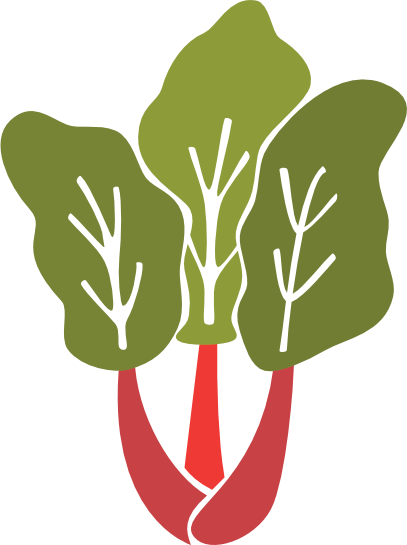Variety
Rhubarb Hawkes’ Champagne
Hawkes' Champagne is recorded as having been introduced by a Mr Hawkes of Loampit Hill, Lewisham, in the mid-nineteenth century. Neither Lewisham archives nor the Garden Museum can find any record ofhim, though Pigot's 1840 street directory does list Edward Hawkes, market gardener, in nearby Lewisham Road — the same road, intriguingly, where Joseph Myatt's famous rhubarb and strawberry nurseries were to be found.
As a name, Hawkes' Champagne might belong to the blatantly optimistic school of Victorian marketing, but the fact remains that while other varieties have come and gone, Hawkes' Champagne continues to attract new fans: in 2003 it even won a coveted Award of Garden Merit from the Royal Horticultural Society. The reason? Well, if it doesn't actually taste like a bottle of 1966 Krug, it is certainly tender and sweet — in fact it is arguably the sweetest rhubarb of all. A medium-sized plant with bright-red stems, it takes a couple ofyears to get established, but like all real luxuries, the wait is well worthwhile.
A traditional variety developed by Edward Hawke in the 1850’s it has a sweet flavor and good color, ideal for crumbles, jams and other dishes. This early to mid-season variety is reliable as an outdoor rhubarb as well as for forcing.
As a name, Hawkes' Champagne might belong to the blatantly optimistic school of Victorian marketing, but the fact remains that while other varieties have come and gone, Hawkes' Champagne continues to attract new fans: in 2003 it even won a coveted Award of Garden Merit from the Royal Horticultural Society. The reason? Well, if it doesn't actually taste like a bottle of 1966 Krug, it is certainly tender and sweet — in fact it is arguably the sweetest rhubarb of all. A medium-sized plant with bright-red stems, it takes a couple ofyears to get established, but like all real luxuries, the wait is well worthwhile.
A traditional variety developed by Edward Hawke in the 1850’s it has a sweet flavor and good color, ideal for crumbles, jams and other dishes. This early to mid-season variety is reliable as an outdoor rhubarb as well as for forcing.
Petiole color : Bright Red
Origin : Angleterre
Year : 1850
Developed by : Probably by a London market gardener called Edward Hawkes from Loampit Hill, Lewisham.
Last update : 2025-07-02
Origin : Angleterre
Year : 1850
Developed by : Probably by a London market gardener called Edward Hawkes from Loampit Hill, Lewisham.
Last update : 2025-07-02


Quotes about Hawkes’ Champagne
1861 — The stalks are of a deep blood-red, rich, free from filament. Its defect is a want'of productiveness and vigor suitable to the garden of the amateur. Type of Bucks.
Source : The Gardener's monthly and horticultural advertiser, Vol3 No1, 1861, 1861
1898 — Hawke’s Champagne, briskly flavoured, red all through the stem; the earliest for forcing or outside culture. We were awarded F.C.C., R.H.S., for this variety ; scarce.
Source : Catalogue of fruit trees cultivated by George Bunyard & Co., Royal Nurseries, Maidstone, 1898-1899, 1898
1898 — Hawke’s Champagne, briskly flavoured, red all through the stem; the earliest for forcing or outside culture. We were awarded F.C.C., R.H.S., for this variety ; scarce.
Source : Catalogue of fruit trees cultivated by George Bunyard & Co., Royal Nurseries, Maidstone, 1898-1899, 1898
2009 — Hawkes' Champagne is recorded as having been introduced by a Mr Hawkes of Loampit Hill, Lewisham, in the mid-nineteenth century. Neither Lewisham archives nor the Garden Museum can find any record ofhim, though Pigot's 1840 street directory does list Edward Hawkes, market gardener, in nearby Lewisham Road — the same road, intriguingly, where Joseph Myatt's famous rhubarb and strawberry nurseries were to be found. As a name, Hawkes' Champagne might belong to the blatantly optimistic school of Victorian marketing, but the fact remains that while other varieties have come and gone, Hawkes' Champagne continues to attract new fans: in 2003 it even won a coveted Award of Garden Merit from the Royal Horticultural Society. The reason? Well, if it doesn't actually taste like a bottle of 1966 Krug, it is certainly tender and sweet — in fact it is arguably the sweetest rhubarb of all. A medium-sized plant with bright-red stems, it takes a couple ofyears to get established, but like all real luxuries, the wait is well worthwhile.
Source : Forgotten fruits - The stories behind Britain’s traditional fruit and vegetables, Christopher Stocks, 2009
2010 — Rhubarb Red Champagne is a very close relative of Hawkes’ Champagne, another long- cultivated variety first introduced in the 1850s, probably by a London market gardener called Edward Hawkes.
Source : Rhubarb, rhubarb: why Victoria still reigns supreme, www.irishtimes.com, 2010
2024 — A traditional variety developed by Edward Hawke in the 1850’s it has a sweet flavour and good colour, ideal for crumbles, jams and other dishes. This early to mid-season variety is reliable as an outdoor rhubarb as well as for forcing.
Source : Brandy Carr Nurseries, UK, Brandy Carr Nurseries, UK, 2024
Return to the list of varieties
Copyright © Christian Sauvé | Rhubarbium.ca - 2024
